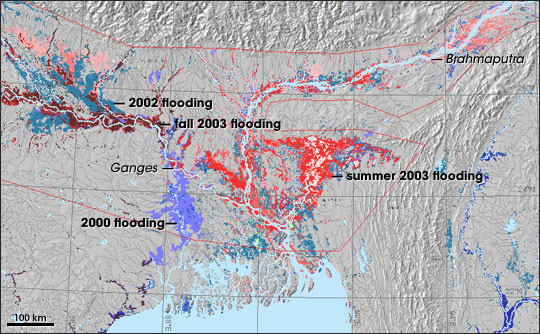

Returning To His First Love | |||
It’s not hard to imagine how rewarding this work must be to Brakenridge. In the summer of 2004, he was contacted by the U.S. State Department, who had seen some of his images on the Internet of the massive flooding in late July and early August that had covered nearly two-thirds of Bangladesh with water. “They wanted a high-quality annotated version of the map, which we quickly made and printed out. We delivered the map, which quickly made it into the hands of the Ambassador and into a diplomatic mail pouch. Within two days, it was in the hands of aid workers in Bangladesh,” said Brakenridge. |
|||
 | |||
“Now I am a scientist,” he continued, “and as a scientist I know that I am judged successful or not by my peers in the traditional scientific manner, through publishing research in journals and speaking at conferences. But personally, to know that the maps we made have helped some person or group in a time of crisis is just as rewarding to me as the more traditional measures of professional success.” “It’s kind of funny, actually, my doing this work. I grew up in the 60s, and the Apollo program was underway. I was very taken by space. In fact, my first desire was to be an astronomer, but instead I became a geologist. I went from wanting to study things ‘way out there’ to having my nose pressed into the dirt. Now I am using space-based technology to observe these ground-based events. It’s like coming full circle.” |
Maps provided by the Dartmouth Flood Observatory to aid organizations like the U.S. State Department and AlertNet enable non-technical people to utilize sophisticated satellite data. This map shows flooded areas detected by MODIS in 2003 (red shades) combined with previous years’ flooding (blue shades). Light blue areas are permanent water bodies. (Map copyright Dartmouth Flood Observatory) | ||
Currently the Dartmouth Flood Observatory receives financial support predominantly from NASA, but they also have some small grants from the United Nations World Meteorological Organization and also from NATO’s Science for Peace Programme. “Today I have two young scientists from Romania across the hall working with my research assistant. They had never been to the U.S. before. They will be here 10 days, courtesy the NATO grant, working out how to integrate flood mapping techniques we developed here into their prediction and flood disaster response efforts.” “I do worry very much about continuity of this project, dependent as it is on grant support. On the other hand, given the degree of interest that has been shown from a long list of nations, agencies, NGOs [non-governmental organizations], and academic institutions, I do feel confident that this effort will survive. I just never realized it would become my full-time job making sure that happens,” Brakenridge said. It’s not a job he expects to quit anytime soon. Despite the worries, he says, “I absolutely love this work.” |
| ||